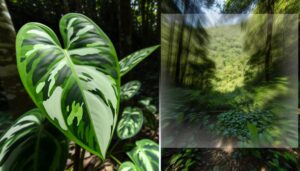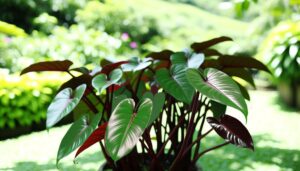What Is a Philodendron Congo Rouge?
Philodendron Congo Rouge, scientifically known as Philodendron tatei, is a robust and upright plant belonging to the Araceae family. Originating from the tropical rainforests of South America, it thrives in humid, shaded environments typical of the understory layer.
The plant features broad, glossy, ovate leaves that range from 30 to 45 cm, starting as vibrant red and maturing into deep green. This species is known for its large, leathery leaves and thick petioles with pinnate venation.
Additionally, it possesses air-purifying qualities that eliminate harmful volatile organic compounds. To discover its ideal growing conditions and more intriguing details, continue exploring.
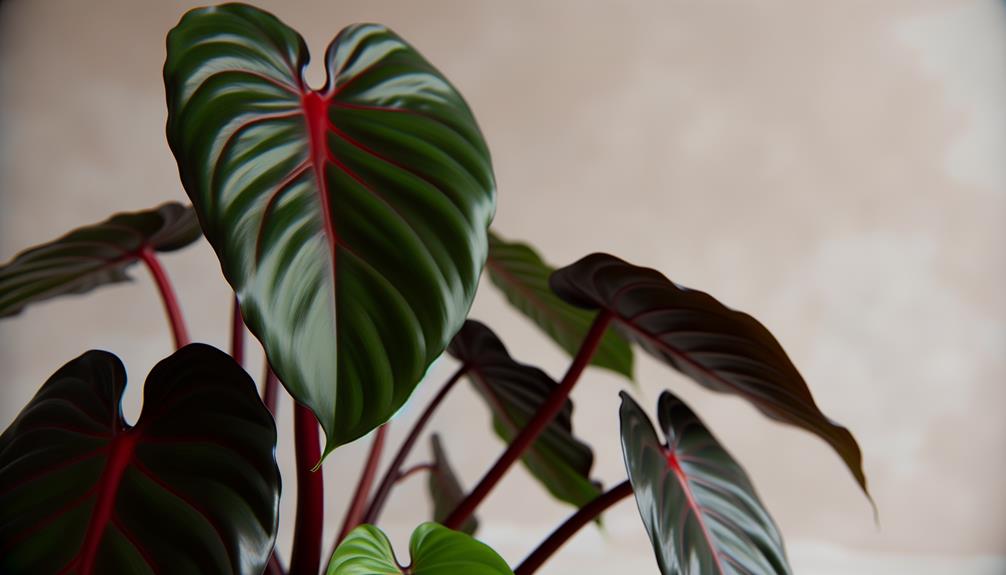
Key Takeaways
- Philodendron Congo Rouge is a compact, upright plant with large, leathery, ovate leaves.
- New leaves emerge vibrant red and mature to deep green, showcasing striking color variations.
- It belongs to the Araceae family and originates from South America's tropical rainforests.
- The plant is known for its air purification qualities, eliminating VOCs like formaldehyde and benzene.
- Philodendron Congo Rouge requires minimal maintenance and thrives in indirect light with occasional watering.
Origins and History
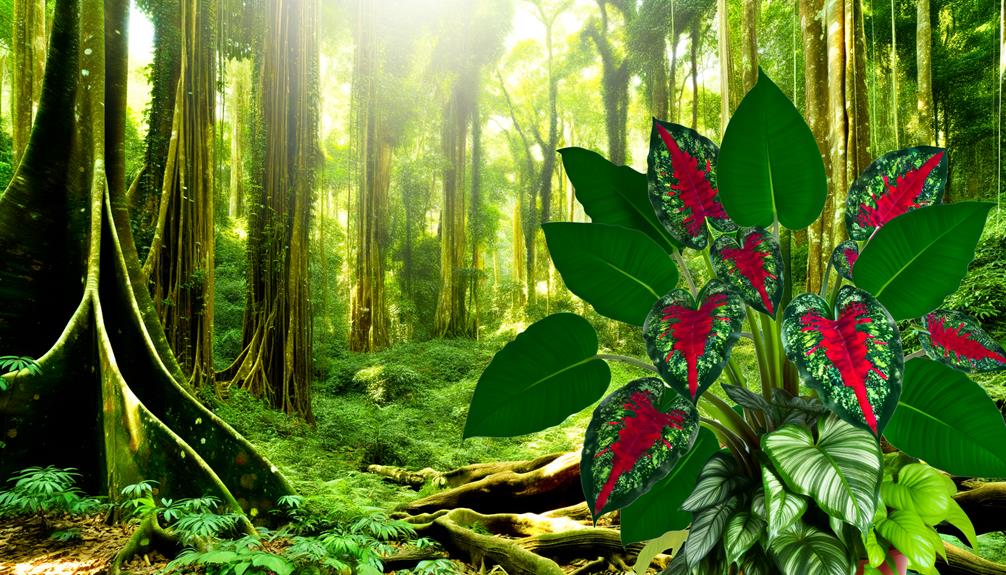
Philodendron Congo Rouge, a member of the Araceae family, traces its origins to the tropical rainforests of South America, where it thrives in the understory layer of the biome.
This plant, scientifically known as Philodendron tatei, is part of a genus that includes hundreds of species adapted to humid and shaded environments. The genus name, Philodendron, derives from Greek words 'philo' (love) and 'dendron' (tree), highlighting its affinity for climbing trees in its native habitat.
The Congo Rouge variant was selectively bred for its robust growth and vibrant foliage. Historically, these plants have been studied for their unique epiphytic growth patterns and their role in indigenous cultures, where they are often used for medicinal and ornamental purposes.
Physical Characteristics
The Philodendron Congo Rouge is characterized by its large, ovate leaves which can reach up to 45 cm in length and exhibit a striking deep burgundy hue, shifting to dark green as they mature.
The robust, upright growth habit, attributable to its semi-epiphytic nature, supports a compact and bushy structure.
Notable for its color variations, the plant showcases a spectrum ranging from vibrant red to a rich, dark maroon, influenced by light exposure and developmental stage.
Leaf Shape and Size
Characterized by their broad, glossy, ovate leaves, Philodendron Congo Rouge exhibits a notable variation in size with mature leaves typically ranging from 30 to 45 centimeters in length. These leaves, belonging to the species Philodendron tatei, display a robust and leathery texture, which contributes to their structural integrity. The leaf blades are often elliptic to oblong in shape, with a smooth, undulating margin. The petioles, or leaf stalks, are thick and sturdy, providing substantial support for the large foliage. The venation pattern is pinnate, with prominent secondary veins that enhance the leaf's aesthetic appeal and functional efficiency in photosynthesis.
| Attribute | Description | Measurement |
|---|---|---|
| Leaf Length | Mature leaves | 30-45 cm |
| Leaf Shape | Ovate to oblong | Broad and glossy |
| Venation | Pinnate pattern | Prominent secondary veins |
Color Variations
Distinctive color variations in Philodendron Congo Rouge contribute to its unique aesthetic, with new leaves typically emerging in vibrant shades of red before shifting to deep green as they mature.
This chromatic shift is a hallmark of Philodendron 'Congo Rouge', a cultivar of the species Philodendron tatei. The juvenile foliage exhibits intense anthocyanin pigmentation, resulting in striking red hues that gradually diminish as chlorophyll production increases.
Mature leaves display a glossy, deep green coloration, indicating a change to photosynthetic efficiency. The interplay of pigments such as anthocyanins and chlorophylls underscores the dynamic physiological processes within the plant.
This color transformation not only enhances aesthetic appeal but also signifies the plant's developmental stages and adaptability to its environment.
Growth Habit
Exhibiting a robust growth habit, Philodendron Congo Rouge typically develops a compact, upright form with thick, leathery leaves that can reach up to 45 cm in length. The leaves are a distinguishing feature, appearing dark green with a slight reddish hue on the undersides. The plant belongs to the Araceae family and is scientifically known as Philodendron 'Congo Rouge'. This species prospers in well-drained soil with moderate moisture levels.
| Attribute | Description |
|---|---|
| Leaf Length | Up to 45 cm |
| Leaf Texture | Thick and leathery |
| Growth Form | Compact and upright |
| Scientific Name | Philodendron 'Congo Rouge' |
This structure supports the plant's ability to thrive in indoor environments, making it a popular choice for enthusiasts seeking a low-maintenance yet visually appealing houseplant.
Ideal Growing Conditions
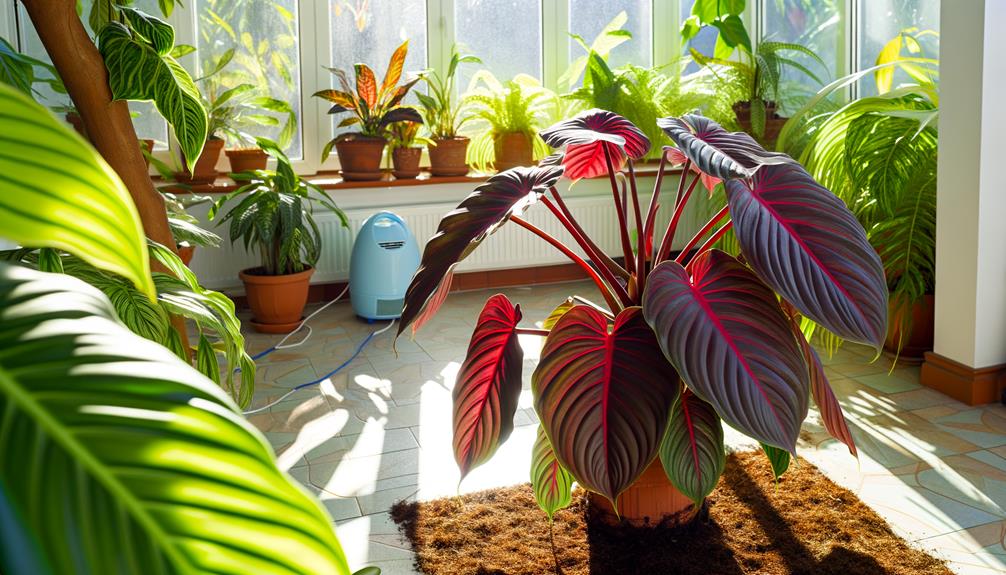
To cultivate Philodendron Congo Rouge efficiently, it is crucial to provide a warm, humid environment with indirect light and well-draining soil. This tropical species, Philodendron 'Congo Rouge', thrives in temperatures ranging from 18-27°C (65-80°F).
Ideal light conditions include bright, indirect sunlight, as direct exposure can scorch the foliage. A potting mix consisting of peat, perlite, and orchid bark ensures sufficient aeration and drainage, preventing root rot.
Maintaining a relative humidity level above 60% is beneficial for robust growth. Additionally, the soil pH should be slightly acidic to neutral, around 6.0-7.0. By replicating these specific conditions, cultivators can promote healthy, vigorous development in their Philodendron Congo Rouge.
Watering and Humidity Needs
Maintaining appropriate moisture levels is crucial for Philodendron Congo Rouge, as both overwatering and underwatering can lead to negative effects on its growth and overall health.
Philodendron Congo Rouge (Philodendron tatei) thrives in consistently moist but well-draining soil. The substrate should be allowed to dry out slightly between waterings to prevent root rot caused by waterlogged conditions.
Relative humidity levels around 60-80% are vital, as this mimics the plant's native tropical environment. Inadequate humidity can result in leaf browning and reduced liveliness. Using a humidity tray or a room humidifier can help maintain these conditions.
Regular monitoring of soil moisture and ambient humidity guarantees the plant remains in an ideal growing state, fostering robust development and vibrant foliage.
Soil and Potting Tips
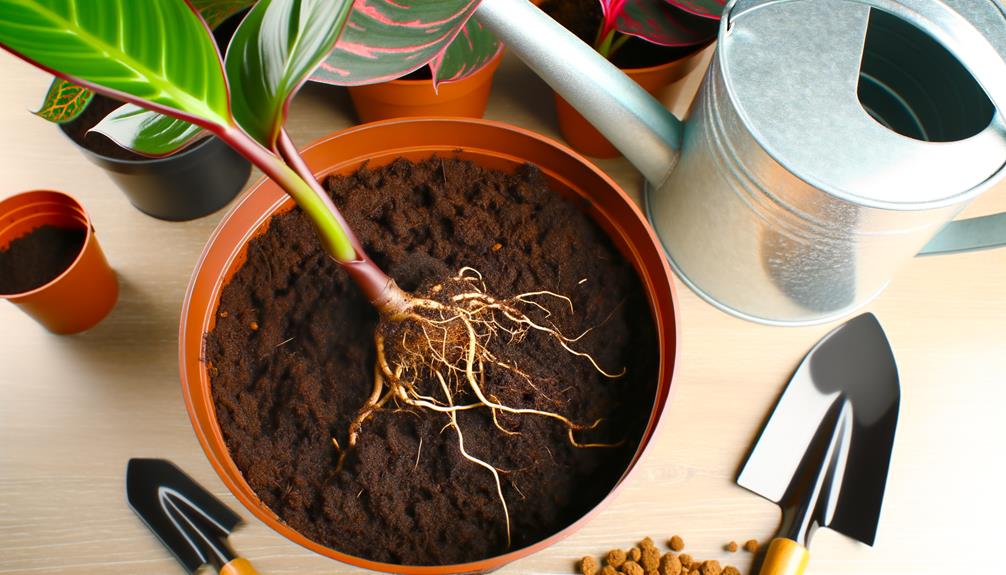
Selecting a suitable soil mix for Philodendron Congo Rouge (Philodendron tatei) is crucial. A preference is for a well-draining, aerated substrate composed of peat, perlite, and orchid bark to support ideal root health and prevent waterlogging. The peat component retains necessary moisture, while perlite guarantees proper aeration, and orchid bark promotes drainage and reduces compaction.
When potting, select containers with ample drainage holes to prevent water accumulation, which can lead to root rot (Pythium spp.). Repotting every 1-2 years is advisable to refresh the soil medium and provide room for root expansion. Make sure the pot size is proportionate to the plant's growth, avoiding excessively large containers that may retain excess moisture.
Common Pests and Issues
Philodendron Congo Rouge (Philodendron tatei) is susceptible to common pests such as spider mites (Tetranychidae), mealybugs (Pseudococcidae), and aphids (Aphidoidea), which can cause significant damage if not promptly managed.
Spider mites typically manifest as fine webbing on the undersides of leaves, leading to stippling and chlorosis. Mealybugs appear as white, cottony masses on stems and leaf axils, excreting honeydew that encourages sooty mold. Aphids, small and often green or black, cluster on new growth, causing distortion and yellowing of leaves.
Effective management includes regular inspection, isolation of infested plants, and the application of horticultural oils or insecticidal soaps. Maintaining optimal humidity and cleanliness can also help mitigate infestations, promoting the overall health of the plant.
Propagation Methods

Propagation of Philodendron Congo Rouge (Philodendron tatei) is commonly achieved through stem cuttings. These cuttings should be taken from healthy, mature plants to secure the best root development. Select a vigorous stem and cut just below a node using a sterilized, sharp instrument. The cutting should ideally be 4-6 inches long with at least two nodes.
Remove the lower leaves to prevent decay and place the cutting in a well-aerated medium such as perlite or sphagnum moss. Maintain high humidity and indirect light to encourage root formation. Rooting hormone can be applied to the cut end to improve rooting efficiency.
After roots have developed sufficiently, usually within 4-6 weeks, the cutting can be transplanted to a suitable potting mix.
Benefits of Growing
Philodendron Congo Rouge (Philodendron 'Congo Rouge') offers multiple advantages for indoor cultivation, including notable air purification capabilities, as the plant aids in the removal of volatile organic compounds (VOCs) from indoor environments.
Its vibrant, deep red foliage provides significant aesthetic enhancement to interior spaces, contributing to biophilic design principles.
Additionally, this species is characterized by its low maintenance requirements, making it an excellent choice for both novice and experienced horticulturists.
Air Purification Qualities
The Philodendron Congo Rouge, known scientifically as Philodendron tatei, displays important air purification qualities by effectively eliminating harmful volatile organic compounds (VOCs) such as formaldehyde, benzene, and trichloroethylene from indoor environments.
This plant species utilizes a complex physiological mechanism involving stomatal uptake and metabolic breakdown of these pollutants. Through the process of phytoremediation, Philodendron tatei can enhance indoor air quality, thereby contributing to a healthier living space.
The leaf structure, characterized by a large surface area and dense stomata, maximizes the absorption of airborne toxins. Additionally, the root microbiome plays a vital role in degrading VOCs, further enhancing the plant's detoxifying capabilities.
Consequently, incorporating Philodendron Congo Rouge into indoor settings can greatly reduce exposure to hazardous chemicals.
Aesthetic Indoor Appeal
Beyond its air purification capacity, Philodendron tatei also offers significant aesthetic appeal. It is characterized by its striking, large, deep red leaves and robust, upright growth habit, making it an attractive addition to any indoor environment.
The broad, glossy leaves, known scientifically as laminae, display a vibrant red hue that matures into a lush dark green, providing a dynamic visual transformation.
The plant's erect stems and dense foliage create a dramatic vertical presence, ideal for accentuating modern interior designs. This species, belonging to the Araceae family, thrives under various lighting conditions, further enhancing its ornamental value.
Philodendron tatei's structural elegance and vivid coloration make it a focal point in botanical collections and a staple in biophilic design spaces.
Low Maintenance Needs
Cultivating Philodendron tatei requires minimal effort, as its adaptive growth habits and resilience to varying environmental conditions make it a low-maintenance choice for indoor horticulture. This species thrives in indirect light and tolerates a range of humidity levels, making it adaptable to diverse indoor environments. Furthermore, its robust nature minimizes the necessity for frequent watering and fertilization, thus reducing upkeep demands. The Philodendron tatei's capacity to withstand occasional neglect without significant adverse effects enhances its appeal to both novice and experienced indoor gardeners.
| Aspect | Description | Benefit |
|---|---|---|
| Light Requirements | Indirect light | Versatile placement options |
| Watering Needs | Infrequent | Low upkeep |
| Humidity Tolerance | Wide range | Adaptable to various settings |
| Soil Type | Well-draining potting mix | Easy maintenance |
| Fertilization | Minimal | Reduced care |
Conclusion
To sum up, *Philodendron 'Congo Rouge'* showcases botanical grace, flourishing under particular horticultural conditions that mirror its original tropical environment.
This plant, with its colorful foliage and strong development, requires accurate watering, humidity, and soil settings to thrive.
Moreover, grasping its susceptibility to pests and successful propagation methods is crucial for maintaining its health.
Consequently, cultivating *Philodendron 'Congo Rouge'* is like fostering a living artwork, where every leaf tells a tale of mindful care and mutual balance with nature.

